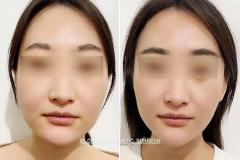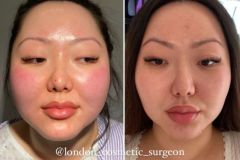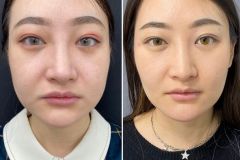Fill out the enquiry form to book an appointment and get the price list.
Buccal Fat Removal
Buccal Fat Removal
The buccal fat pads (Bichat’s fat pad) function to fill the deep tissue spaces, to act as gliding pads when chewing and mimetic muscles contract, and to cushion important structures. The volume of the buccal fat pad may change throughout a person’s life and the size and volume is different in different ethnicity.
The volume of the buccal fat pad is relatively consistent. This is true for men and women throughout their lives, despite weight fluctuations, and in people with varying body mass indexes. In fact, the deeply located buccal fat pad stubbornly persists (to a point) despite loss of weight and loss of subcutaneous fat.
The size of your buccal fat pads affects your face shape. If you have larger buccal fat pads, you might feel like your face is too round or full especially in the cheek area. You may like to have more defined cheekbones and jawline also contoured slimmer face by removing some of your buccal fat pad. Buccal fat removal is also important to create more feminine face.
What is buccal fat removal?
Buccal fat removal or bichectomy is a surgical procedure designed to remove excess buccal fat in the cheeks to give more slimmer and contoured effect. It can be performed under local anaesthesia and recovery time is very short up to 1-3 days. It is done with a small incision inside your mouth on the inner side of the cheeks and fat is removed from the same little incision. After the procedure a self-dissolving suture can be used.
The surgery can be done alone or with another form of plastic surgery, such as:
- Facelift
- Eyelid surgery
- Rhinoplasty
- Chin Implants
- Breast Surgery
- Tummy tuck
After the surgery patients are not allowed to eat or drink hot food/drinks for 3 days and will need to take antibiotic tablets for 3 days. Patients can go back to work immediately after the procedure. Minimum swelling and pain expected first 3-5 days and results will settle in 3-4 weeks.
FREQUENTLY ASKED QUESTIONS:
- Who is a good candidate for buccal fat removal?
- Patients who have more round and fuller face and wants to have a slimmer and more defined face. Masseter botox also can be combined with the buccal fat removal to have the maximum slimming effect
- Patients who have a slim face but fuller cheeks
- Patients who are looking for a more feminine look
- Who is not a good candidate for buccal fat removal?
- Patients with a narrow and slim face with no fullness in the cheek area,
- Older patients especially if there is no volume in the midface and cheek area, the surgery might cause sunken cheeks if more fat is removed.
- Will there be any bandages on my face after the buccal fat removal surgery?
- Buccal fat removal is done intraorally means all work will be done inside your mouth so there will be no bandages or dressings
- Will I be able to eat and drink normally after the surgery?
- You can drink and eat normally after a couple of hours
- Very hot food and drinks are not allowed in the first 3 days
- What happens if I have unpleasant and asymmetric results?
- Buccal fat removal is always done symmetrically with measuring the size in both side, but buccal fat is located under the mimics and chewing muscles and when you start using those muscles healing can be slightly different and minor asymmetries can be seen
- What are the potential complications of buccal fat removal?
- Buccal fat removal is generally considered safe but as all procedures, there are some risks of infection, bleeding and haematoma, numbness in the area
- In case of a complication, you may need to use some other medicines like antibiotics, steroids etc, also your surgeon may open the wound again to treat the haematoma or infection.



